#DBT resources
Text
If you are like me and live with BPD, I’m sure you may have at least heard of DBT. Dialectical Behavioral Therapy is the type of therapy that has really turned my life around, so I’d like to make a Masterlist of resources both free and with cost.
FREE RESOURCES FOR LEARNING DBT:
A great website that teaches the skills is ⬇️
A great YouTube channel that has videos of Marsha (the creator of DBT)
A great podcast that teaches and discusses the skills is:
DBT RESOURCES THAT COST MONEY:
This is a great easy to learn card deck with the skills explained in concise ways.
This is a great workbook. It was made BY the lady who CREATED DBT.
This is a great book that delves into DBT at its core (and isn’t so much activity focused vs. explaining each skill)
That’s it! I’m not saying this type of therapy is FOR SURE going to be the right therapy for you, but it’s SO worth trying if you have Borderline Personality Disorder like me.
Hopefully this helps someone!
-Velvet Rose Kthonia 🥀
#DBT#dbt skills#dbt therapy#DBT resources#therapy#dialectical behavior therapy#resources#free#paid#mental heath support#BPD#actually BPD#borderline personality disorder#Spotify
33 notes
·
View notes
Text
DBT Resources Masterpost
Helpful resources for all your Dialectical Behaviour Therapy needs! I will be updating this post as I find more.
The Dialectical Behavior Therapy Skills Workbook by M. McKay, J. Wood and J. Brantley : A clear and concise guide to the basics of learning DBT skills.
The DBT Travel Guide app on the App Store and on Google Play: Quick list of DBT skills to try for your specific emotion, also includes an interface for diary cards.
DBTSelfHelp.com: A variety of tools including videos, articles, flash cards, DBT skills, etc.
Dialectical Behavior Therapy Official Site
Therapist Aid DBT Worksheets
DBT Tools: An index of DBT skills.
Psychology Today: Search engine for mental health professionals in your area with the ability to filter for specific issues and therapy modalities.
3 notes
·
View notes
Text
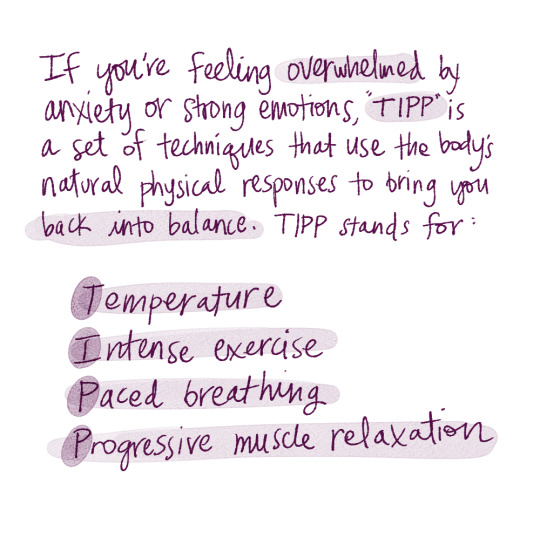
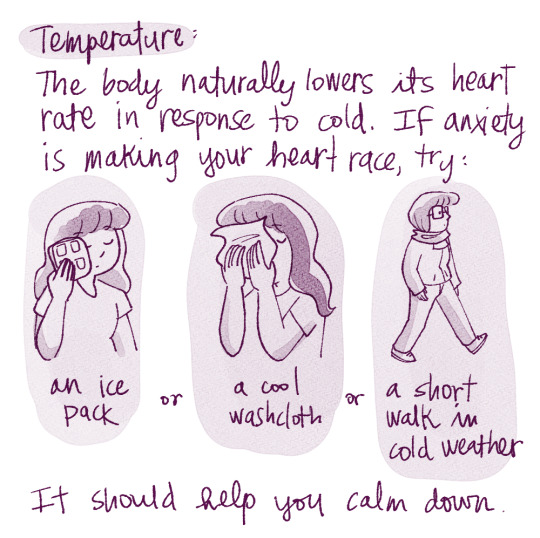

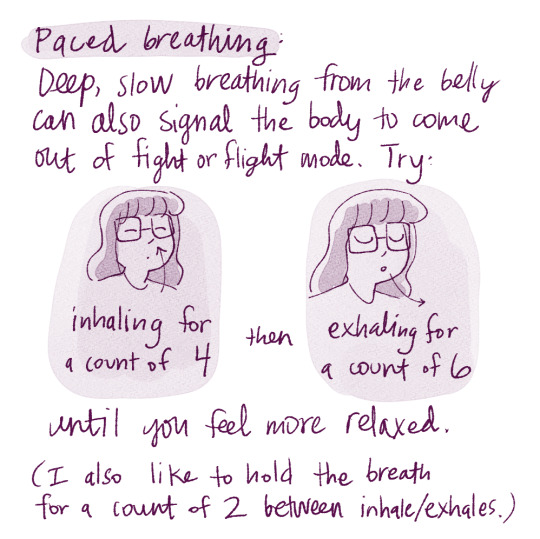
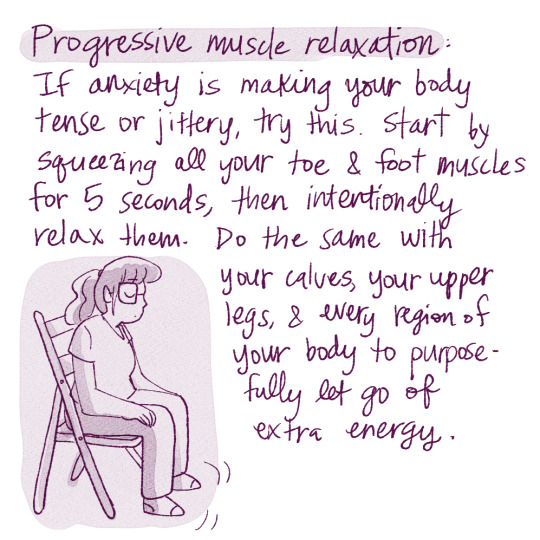
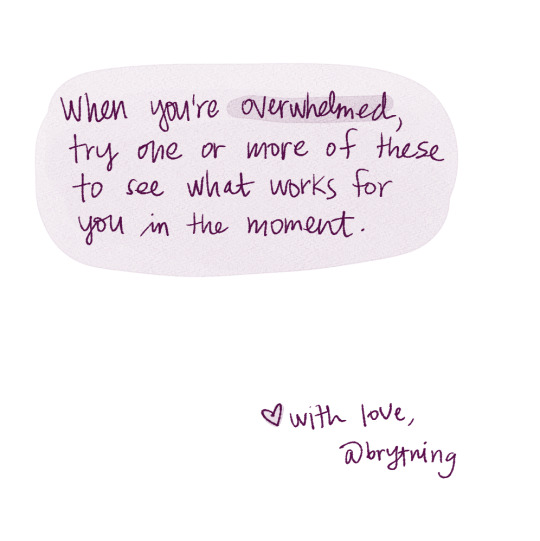
I was talking to my therapist about some anxiety symptoms --- "In my mind, I know I'm going to be perfectly okay, but my body doesn't listen and reacts anyway" --- and she recommended TIPP as strategies to keep in my toolbox of dealing with distress in the moment. I really appreciate having more than one option to try in moments of overwhelm!
Transcription below:
If you're feeling overwhelmed by anxiety or other strong emotions, TIPP is a set of techniques that use the body's natural physical responses to bring you back into balance.
TIPP stands for
temperature
intense exercise
paced breathing
progressive muscle relaxation
Temperature:
The body naturally lowers its heart rate in response to cold. If anxiety is making your heart race, try an ice pack, a cool washcloth, or a walk outside in cool weather, and it should help you calm down.
Intense exercise:
Anxiety is typically a symptom of your body going into fight/flight mode. If your body is coursing with nervous energy, burn it off with 10 minutes of jumping jacks, dancing, climbing stairs, or another cardio activity to complete the stress response cycle.
Paced breathing:
Deep, slow breathing from the belly can also help signal the body to come out of fight/flight mode. Try inhaling for a count of four and exhaling for a count of six until you feel more relaxed. (I like to hold the breath for a count of two between each inhale and exhale.)
Progressive muscle relaxation:
If anxiety makes your body tense up, try this. Start by squeezing the muscles in your toes and feet for five seconds, and then intentionally relax them. Move up to the calves, up your legs, and every region of your body to purposefully let go of extra energy.
When you're feeling overwhelmed, try one or more of these to see what works for you.
#self-care sunday#self-care#anxiety#anxiety relief#managing anxiety#dbt#tipp#mental health#mental health resources#stress
8K notes
·
View notes
Text
Emotional Regulation- what's it all about?

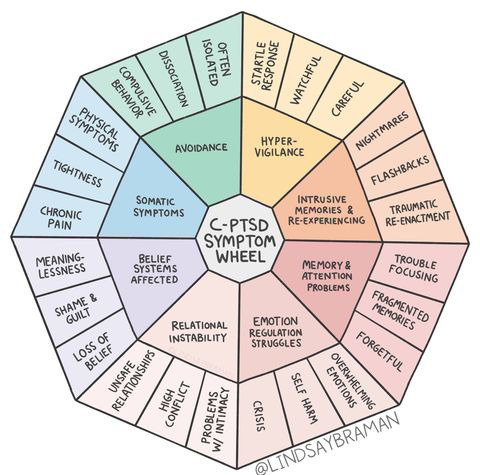
Emotional regulation is the work of releasing pent up stress from your nervous system.
Your body has an entire system of automatic stress responses. Some of which can be born out of hard wired prolonged exposure to trauma in our childhoods.
With no proper regulation from our abusive & neglectful parents, many of us are still stuck in these same fear responses from our childhoods. Which means a lot of that fear, sadness, guilt, and shame, reappears in the form of how we cope now as an adult.
By learning how to recognize which state of survival you're in- and you can be in all states at different times and triggers- you can then work on giving your body a more directed route to releasing the pent up exhaustion, fear, tension, and panic.
Which in turn gives us more room to breathe easier when we are feeling stress, panicked, and triggered.
There are many techniques to help with emotional regulation. Somatics is the practice of moving your body to release the energy.
This is why everyone will scream yoga and exercise at you. But its not just limited to those two types of movements.
If you are bed bound, somatics can be as simple as raising your arms, lifting your legs, and rolling your neck.
The key idea is to recognize when you're overwhelmed, panicked, and triggered in your day to day life. Work real hard on bringing these moments into your awareness. What are your thoughts like? What are your reactions?
From there we work to integrate a basic somatic framework over time. This can look like working hard to incorporate some form of comfort, movement, and acceptance for the physical discomforts of these moments.
A basic framework can include:
Butterfly hugs (put ur hand over ur heart)
Self hugs
Hold your shoulders
Rub your shoulders, arms, tummy, and legs
Lift ur shoulders, shake ur arms, clench ur fists
Wiggle in ur seat
Raise ur legs, stomp your feet gently in place, roll ur ankles
Deep breathing
Groaning, sighing, screaming, making noise
Humming or singing
Outwardly showing emotions on your face
Cold/warm compress or towel
Weighted blankets or comfort items
Sensory stems
These are just a few examples. You can literally do whatever types of movements that feel natural for you.
The secondary idea of emotional regulation is self expression.
That's why it's okay to groan and scream and be loud and expressive in these moments, if you need to. Remember that most often panic attacks, stress, anxiety, and triggers are deeply emotional responses to very personal scenarios and traumas that we have endured in our past. Some of these fears stem from some really scary places. It makes a lot of sense that you might need to scream, cower in fear, or use facial expressions in these moments.
Oftentimes in abusive environments we are restrained from doing so by our abusers. When in reality, these are the standard reactions for what we went through. These are the types of reactions that our bodies are repressing.
It can feel overwhelming to think about acting in such ways, especially if you're not able to practice these in peace, solitude, and safety. But please know that how you cope is an extremely personal and extremely precious part of who you are. Do whatever you need to do for your health and safety and stability and peace of mind. That should be the main goal.
One last thing about emotional regulation to remember, is that the goal is to not be "happy" or at a "peaceful baseline" all the time.
The goal is to allow the anger, allow the sadness and grief and all other emotional signals in-- and then express them in healthier ways than what you're doing now.
Because at the end of the day, groaning and pitching an intended hissy fit in the privacy and safety of your own home, is a much better and healthier way to cope than hurting yourself.
Allow your inner teen the proper emotional outlets your parents stole from you.
This is the work of emotional regulation.
[self regulation chart source- primaltrust-official]
"The Autonomic Nervous System (ANS) communicates to us through our feelings and our sensations in the body. By learning how to recognize our ANS states, we can become better equipped with knowing what we can do to help ourselves in times of discomfort or distress.
Many people are aware of the fight/flight state, but there is often confusion with freeze and shut down states, which are actually different.
Dorsal vagal shutdown is a state of parasympathetic collapse, and because of this, a little movement and stimulation of the vagus nerve (since this nerve governs the parasympathetic response) is helpful. On the other hand, a freeze state is a mixture of sympathetic and parasympathetic (the dorsal vagal shutdown) immobilization, which to our nervous system is like having a foot on the gas and a foot on the brakes at the same time. In this state, the nervous system needs to be shown safety, so it can come out of paralysis, relax and then move energy as needed.
A telltale physical sign of being in freeze is having very tight, sore muscles, or noticing you are 'bracing' in your body, as if preparing for impact. Panic attacks can also occur in the state, which is a step beyond the anxiety experienced and fight/flight.
The aim of all the suggested exercises in this post is to help the body come into a healthy (not dorsal vagal shutdown!) parasympathetic state- ventral vagal- but to get there, you might journey from freeze to fight/flight for example, or dorsal vagal to fight/flight. This is very normal and can be explained wonderfully by the Polyvagal Ladder (see the teachings of Deb Dana for more). The goal is to not be in ventral vagal all the time. Our nervous system is highly intelligent and will flow between states as needed, thus the aim is to allow this flow, versus getting stuck in any shut down, freeze, or fight/flight state for too long."
[C-PTSD symptom wheel source- Lindsay Braman]
"This new C-PTSD symptom wheel resource is a tool for education and for advocacy.
The World Health Organization's diagnostic criteria for Complex Post-Traumatic Stress Disorder are split into 8 distinct categories. These categories were mapped by Dr. Wei-May Su and Dr. Louise Stone in an Australian medical journal in 2020. Simplifying and then building off their work* to highlight specific ways these symptom categories show up in a survivor's life, I've created this radial chart showing how the constellation of symptoms experienced by survivors of complex trauma can be organized under the heading of C-PTSD.
I often avoid creating art that can be used for diagnosis or self-diagnosis, but the fact is, resources and awareness are desperately needed on the topic of C-PTSD. See, although it has been recognized by the World Health organization since 2020, the USA's diagnostic manual, the DSM-5, doesn't include C-PTSD. Because it's omitted from the DSM, many therapists aren't trained to recognize it or treat it. Insurance won't cover treatment, and too often people get misdiagnosed and given ineffective treatments.
Historically, mental health providers haven't done a great job of understanding and categorizing experiences of complex trauma survivors, but through education and advocacy, we can change that."
🌸🌸🌸🌸🌸🌸
Hope this helps
🌸🌸🌸🌸🌸🌸
#recovery#ptsd#trauma#mental health#boundaries#healing#healing thoughts#cptsd#actually traumatized#trauma awareness#trauma informed#emotions#bpd#actually borderline#mental health resources#resources#emotional regulation#dbt#somatics#trauma therapy#self help#self care#anxiety#depression
72 notes
·
View notes
Text

TIPP
Use this skill when you are overwhelmed by intense emotions or are feeling the urge to self-injure.
*If you’re in crisis and are having suicidal thoughts please call a Crisis Hotline! (Call 988 in the US)
T - Temperature: To relax fast or distract your mind with sensation, hold an ice pack to your cheeks or eyes or dunk your face in a bowl of ice water for at least 30 seconds to activate your Diver Reflex*.
*If you have high blood pressure, talk to your doctor before trying.
I - Intense Exercise: Doing a few minutes of vigorous exercise will release Endorphins. Try a few minutes of Jumping Jacks or running in place (or around the block). Play your favorite fast paced song and dance it out.
P - Paced Breathing: Breathe deeply into your belly, expanding your lungs as much as you can. Pace your inhales and exhales to 5-6 per minute. Then make your exhales longer than your inhales (5 seconds in, 7 seconds out).
*Try a 60 bpm Metronome track from your music streaming app or YouTube for pacing.
P - Paired Muscle Relaxation: Breathing deeply, tense your muscles (not so much that you cramp up) section by section, move your focus from your feet up your body. Tense up with every inhale, relaxing and melting with every exhale.
*More DBT guides here*
#dbt#dbt guide#dbt skill#dbt skills#dialectical behavior therapy#therapy#resource#resources#bpd thoughts#actually bpd#bpd#borderline pd#borderline personality#bpd life#bpd problems#bpd shit#bpd stuff#crisis plan#crisis management#distress#tolerance#distress tolerance#TIPP#tipp skill
100 notes
·
View notes
Text
if you have bpd, i recommend this app. also if you have any other resources, i am in desperate need to have them. might get more bpd recovery positivity posts (i know that i’m usually debating whether people with bpd should use a lot of the resources because normally when i try to get better, i get worse but i have hope this time)
i’ll rate each part of it next time i use them
#bpd resources#recovery#actually borderline#mental illness#bpd recovery#borderline personality disorder#dbt skills
4 notes
·
View notes
Text
A Quick Exercise: Challenge Self-Hate
"I don't deserve to get what I want or need."
How I can challenge this feeling: ________
"If I make a request, this shows that I am weak."
How I can challenge this feeling: ________
"I must be really inadequate if I can't fix this myself."
How I can challenge this feeling: ________
"Making requests is pushy, bad, self-centered, selfish, etc."
How I can challenge this feeling: ________
"Obviously, the problem is just in my head. If I would just think differently I wouldn't have to bother everybody else."
How I can challenge this feeling: ________
"I should be willing to sacrifice my own needs for others."
How I can challenge this feeling: ________
Remember, you are allowed to have wants and needs, you have a right to the things you need even if it may inconvenience others, and asking for what you need does not make you a selfish person. You deserve to take up space, you have the right to live because you are alive.
#treatment mall#dbt#dbt therapy#dbt skills#dbt exercise#mental health positivity#mental health awareness#mental health resources#mental health recovery#mental health support#interpersonal effectiveness#personality disorders#borderline personality disorder#bpd#living with bpd#actually bpd#actually borderline#avpd#ppd#spd#stpd#apd#hpd#npd#dpd#ocpd#borderline personality traits#bpd traits
129 notes
·
View notes
Note
hi, im a different anon from the one asking about therapy alternatives. i saw in your response about DBT skills, can you please help share/point to helpful DBT resources? thank you sm
Hi anon,
This is one of my favourites right here.
If you have something you are struggling with specifically, I can help direct you to skills that might be useful for you. It can be overwhelming at first because there are so many skills, it can be hard to know where to start.
I haven't finished writing about all of them yet, but I am working on a quick definition of multiple skills that you can find here, so you have an idea of where you might want to start.
April
22 notes
·
View notes
Text
Your Legitimate Rights (According to DBT)

4 notes
·
View notes
Text
Skillful Sunday!
Today's skill is STOP!
Type: Distress Tolerance
Description: Before you react, STOP!
Stop! Tell yourself to pause and take a second, you can even say "stop" out loud.
Take a breath. Inhale deeply and fully feel the exhale.
Observe the situation. What is happening? What are you thinking? What are you feeling? Stick to the facts.
Proceed mindfully. Ask your wise mind what actions will improve your thoughts and feelings and which will make them worse, and proceed effectively.
Useful when: When distressing situations arise, our emotions can get us to act without thinking. STOP helps keep you in control of your actions.
Do your best this week, everyone! You can do it!
1 note
·
View note
Text
oh my god ppl on Twitter are trying to explain what BPD is and what causes it to me and I'm just like. I have lived it thank you
1 note
·
View note
Text
I'm getting depressingly good at identifying the formula for Pop Academic Books About ADHD.
Regardless of their philosophy it pretty much goes like this:
1. Emotionally sensitive essay about the struggle of ADHD and the author's personal experience with it as both a person with ADHD and a healthcare professional.
2. Either during or directly following this, a lightly explicated catalogue of symptoms, illustrated by anecdotes from patient case studies. Optional: frequent, heavy use of metaphor to explain ADHD-driven behavior.
3. Several chapters follow, each dedicated to a symptom; these have a mini-formula of their own. They open with a patient case study, discuss the highly relatable aspects of the specific symptom or behavior, then offer some lightweight examples of a treatment for the symptom, usually accompanied by follow up results from the earlier case studies.
4. Somewhere around halfway-to-two-thirds through the book, the author introduces the more in-depth explication of the treatment system (often their own homebrew) they are advocating. These are generally both personally-driven (as opposed to suggested cultural changes, which makes sense given these books' target audience, more on this later) and composed of an elaborate system of either behavior alteration or mental reframing. Whether this system is actually implementable by the average reader varies wildly.
5. A brief optional section on how to make use of ADHD as a tool (usually referring to ADHD or some of its symptoms as a superpower at least once). Sometimes this section restates the importance of using the systems from part 4 to harness that superpower. Frequently, if present, it feels like an afterthought.
6. Summation and list of further resources, often including other books which follow this formula.
I know I'm being a little sarcastic, but realistically there's nothing inherently wrong about the formula, like in itself it's not a red flag. It's just hilariously recognizable once you've noticed it.
It makes sense that these books advocate for the Reader With ADHD undertaking personal responsibility for their treatment, since these are in the tradition of self-help publishing. They're aimed at people who are already interested in doing their own research on their disability and possible ways to handle it. It's not really fair to ask them to be policy manuals, but I do find it interesting that even books which advocate stuff like volunteering (for whatever reason, usually to do with socialization issues and isolation, often DBT-adjacent) never suggest disability activism either generally or with an ADHD-specific bent.
None of these books suggest that perhaps life with ADHD could be made easier with increased accommodations or ease of medication access, and that it might be in a person's best interest to engage in political advocacy surrounding these and other disability-related issues. Or that activism related to ADHD might help to give someone with ADHD a stronger sense of ownership of their unique neurology. Or that if you have ADHD the idea of activism or even medical self-advocacy is crushingly stressful, and ways that stress might be dealt with.
It does make me want to write one of my own. "The Deviant Chaos Guide To Being A Miscreant With ADHD". Includes chapters on how to get an actual accurate assessment, tips for managing a prescription for a controlled substance, medical and psychiatric self-advocacy for people who are conditioned against confrontation, When To Lie About Being Neurodivergent, policy suggestions for ADHD-related legislation, tips for activism while executively dysfunked, and to close the book a biting satire of the pop media idea of self-care. ("Feeling sad? Make yourself a nice pot of chicken soup from scratch and you'll feel better in no time. Stay tuned after this rambling personal essay for the most mediocre chicken soup recipe you've ever seen!" "Have you considered planning and executing an overly elaborate criminal heist as a way to meet people and stay busy?")
Every case study or personal anecdote in the book will have a different name and demographics attached but will also make it obvious that they are all really just me, in the prose equivalent of a cheap wig, writing about my life. "Kelly, age seven, says she struggles to stay organized using the systems neurotypical children might find easy. I had to design my own accounting spreadsheet in order to make sure I always have enough in checking to cover the mortgage, she told me, fidgeting with the pop socket on her smartphone."
I feel a little bad making fun, because these books are often the best resource people can get (in itself concerning). It's like how despite my dislike of AA, I don't dunk on it in public because I don't want to offer people an excuse not to seek help. It feels like punching down to criticize these books, even though it's a swing at an industry that is mainly, it seems, here to profit from me. But one does get tired of skimming the hype for the real content only to find the real content isn't that useful either.
Les (not his real name) was diagnosed at the age of 236. Charming, well-read, and wealthy, he still spent much of his afterlife feeling deeply inadequate about his perceived shortcomings. "Vampire culture doesn't really acknowledge ADHD as a condition," he says. "My sire wouldn't understand, even though he probably has it as well. You should see the number of coffins containing the soil of his homeland that he's left lying forgotten all over Europe." A late diagnosis validated his feelings of difference, but on its own can't help when he hyperfocuses on seducing mortals who cross his path and forgets to get home before sunrise. "I have stock in sunburn gel companies," he jokes.
6K notes
·
View notes
Text
Thought I’d share some Deep Breathing gifs that I’ve found helpful to focus on when I need something tangible to calm myself. Just found these in a Google search, there’s so many others but these were the ones I’ve used in the last year.
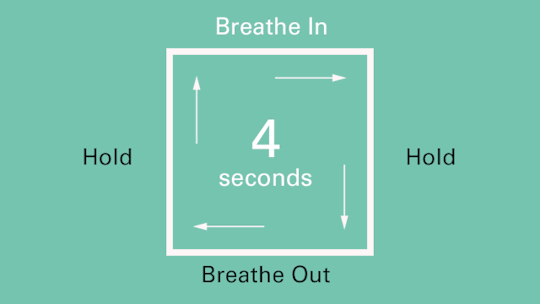
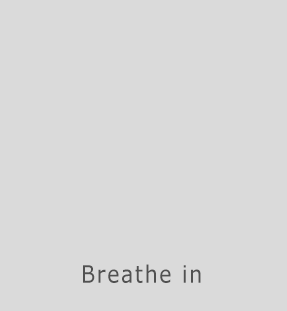


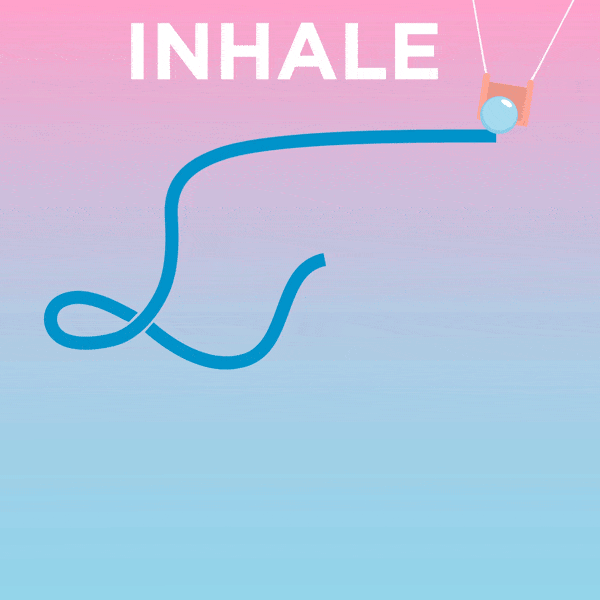
#anxiety#breathing#gif#breathing gif#anxious#TIPP skill#TIPP#DBT#bpd#bpd thoughts#actually bpd#panic attack#breathing techniques#breathe deep#deep breath#deep breathing#help#resource#resources#tools#toolbox#box breathing#yoga breathing#yoga breath#calm#calming#focus
40 notes
·
View notes
Text
Sometimes I don't notice how high risk I am for an episode until I'm literally in the middle of it. It occurred to me while I was writing a fake letter with muscle memory because I couldn't see through my tears that:
I was unable to take my meds last night because my stomach pain was too severe for me to swallow my pills
I am on the first day of my cycle
I did not have therapy this week (Tuesdays) because my therapist is on vacation
It was 3am
When we're at high risk and are trying to use skills to keep ourselves out of an extreme emotional response, it is best to go with familiar ones, or ones that have worked in the past, before trying something new, simply because we don't know what to expect, yet.
I made the mistake of diving headfirst into a skill I haven't tried in a long time (letter writing) because I've been stressing about a conversation, and it culminated into an episode. I got through it safely by riding the wave and acting opposite to urge (for me this means freezing in place and not moving, because my urge is to lash out at myself and self-injure).
The journey isn't always pretty, progress isn't always a straight line, and you're gonna mess up sometimes. Take caution with new exercises, because you might overwhelm yourself, which could make you believe that the skills don't work or will make things worse. The safest time to try a new skill is when you're not in need of it, just to see how you like it as an activity. I enjoy writing, and am an experienced stream of consciousness journaler. However, there's a big difference between talking to yourself and talking to someone else, even if you never intend to share the letter, and it overwhelmed me in a way I did not expect.
The next time I try letter writing, I will consult my Wise Mind and make sure I'm in a secure enough state physically to confront emotions as intense as the ones I was feeling.
#hellbrain dump#dbt#dbt therapy#dbt exercise#dbt skills#bpd#bpd support#bpd recovery#mental health support#mental health resources#borderline personality disorder#borderline pd#living with bpd#living with borderline#actually bpd#actually borderline#bpd problems#bpd life#bpd shit#quiet bpd
34 notes
·
View notes